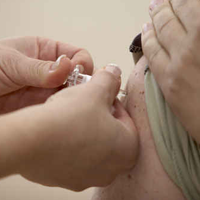Article
CDC Gets it Right: Flu Shot Three Times Better than Last Year
Author(s):
This season's flu shot is 60% effective--much better than last year's 23% score, the US Centers for Disease Control and Prevention reports.

Flu activity is in full swing in the US, according to the US Centers for Disease Control and Prevention (CDC) with outbreaks reported in 33 states.
The good news is it could be worse: this year's vaccine is working much better than last year's and should prevent the flu in 60% of people who get the shot.
The most frequently identified influenza virus type reported by public health laboratories during the week ending February 27 was influenza A viruses, with influenza A (H1N1)pdm09 viruses predominating.
According to the CDC,
During the week ending February 27, 791 (73.4%) of the 1,078 influenza-positive tests reported to CDC by public health laboratories were influenza A viruses and 287 (26.6%) were influenza B viruses. Of the 779 influenza A viruses that were subtyped, 72 (9.2%) were H3 viruses and 707 (90.8%) were (H1N1)pdm09 viruses.
Cumulatively from October 4, 2015-February 27, 2016, influenza A (H1N1)pdm09 viruses were predominant in all four age groups (0-4 years age group (69.9%), 5-24 years age group (48.3%), 25-64 years age group (71.2%), and in ages 65 years and older (45.2%).
Since October 1, 2015, CDC has tested 554 influenza A (H1N1)pdm09, 326 influenza A (H3N2), and 321 influenza B viruses for resistance to the neuraminidase inhibitors antiviral drugs. While the vast majority of the viruses that have been tested are sensitive to oseltamivir, zanamivir, and peramivir, so far this season, 2 (0.4%) influenza A (H1N1)pdm09 viruses have showed resistance to oseltamivir and peramivir (but both were sensitive to zanamivir).
The CDC's full report is here.





